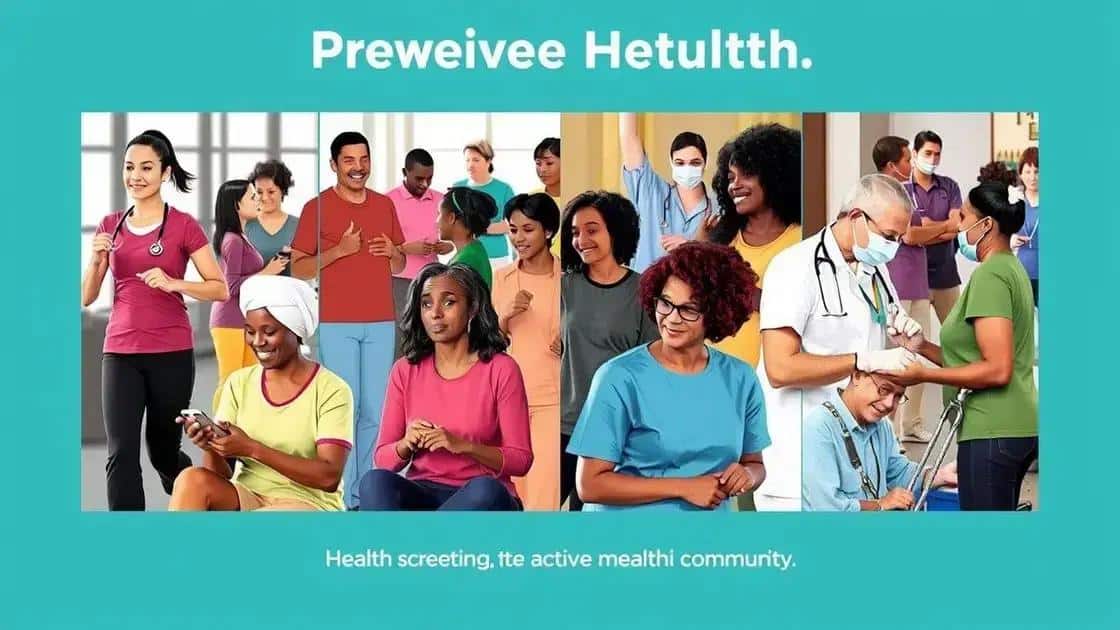Insights on preventive health initiatives: essential strategies

Community involvement in health prevention enhances program effectiveness by fostering ownership, educating residents, and leveraging local resources to address specific health needs.
Insights on preventive health initiatives play a crucial role in maintaining overall well-being. Have you considered how such strategies can impact your life? Let’s dive into key approaches that empower individuals and communities.
Understanding preventive health initiatives
Understanding preventive health initiatives is crucial to improving individual and community well-being. These initiatives focus on preventing diseases before they occur, promoting healthy lifestyles and regular screenings.
What are Preventive Health Initiatives?
Preventive health initiatives are programs and strategies designed to encourage healthy behaviors and reduce health risks. They provide education on nutrition, exercise, and regular medical check-ups.
Key Components of Successful Initiatives
- Education: Informing the public about health risks and healthy practices.
- Access: Making healthcare services more accessible to everyone.
- Community Engagement: Involving local organizations and citizens in health programs.
Efforts like these can lead to healthier communities and lower healthcare costs. For instance, studies have shown that areas with active preventive health programs experience reduced rates of chronic diseases.
Moreover, preventive health initiatives help identify health issues early, allowing for timely interventions. Individuals are encouraged to adopt healthier habits, such as regular exercise, balanced diets, and routine health screenings. This proactive approach can significantly enhance life expectancy.
Examples of Preventive Health Initiatives
Several successful initiatives can serve as models. Vaccination programs, for example, have dramatically reduced the prevalence of diseases like measles and influenza. Equally, health fairs offer free screenings and educational workshops, empowering communities to take control of their health.
In addition, workplace wellness programs can greatly impact employee health by promoting physical activity and mental well-being. These initiatives foster a culture of health in various settings and are essential to combating public health challenges. By understanding these efforts, everyone can play a role in enhancing community health.
Benefits of preventive health measures

The benefits of preventive health measures are substantial and affect everyone in the community. By focusing on prevention, we can significantly reduce the incidence of chronic diseases and enhance the quality of life.
Improved Overall Health
One of the primary benefits of preventive health measures is improved overall health. When individuals adopt healthy habits early, they are less likely to develop serious health conditions later in life. Regular check-ups and screenings allow for early detection of potential issues.
Cost Savings
- Decreased Medical Costs: Preventive measures often result in lower healthcare costs over time.
- Reduced Hospital Visits: By preventing diseases, people spend less time in hospitals.
- Less Medication Needed: Healthy lifestyles can lead to decreased reliance on medications.
Additionally, preventive health measures can save money for both individuals and healthcare systems. By investing in prevention, the burden on emergency services and treatments can decrease significantly.
Another important advantage is the enhancement of mental health. Engaging in regular physical activity and maintaining a balanced diet can improve mood and reduce the risk of depression. Moreover, preventive initiatives often promote social interactions, which contribute to better mental well-being.
Increased Productivity
When individuals are healthy, their productivity often increases. They miss fewer days of work and are generally more engaged. Healthy communities are vibrant and active, leading to overall economic growth.
Furthermore, preventive health measures foster a culture of wellness within communities. Education programs and workshops allow people to learn more about their health and how to take care of it proactively. This knowledge empowers individuals to make informed choices about their health, reinforcing the benefits of preventive action.
How to implement effective initiatives
Implementing effective preventive health initiatives requires strategic planning and community involvement. By engaging stakeholders, communities can create programs that truly meet their needs.
Steps for Implementation
One important step is to assess community needs. This can involve surveys, focus groups, or meetings to gather input from residents about their health concerns. Understanding local health challenges is essential for developing relevant initiatives.
Building a Collaborative Team
Next, it is vital to build a collaborative team of healthcare providers, community leaders, and volunteers. This team can work together to design and implement programs that address key health issues. Engaging local organizations can also leverage additional resources and expertise.
- Identify Key Stakeholders: Who in the community can support the initiative?
- Form Partnerships: Collaborate with local health departments or universities.
- Develop a Strategy: Outline the goals and actions needed to achieve success.
Ongoing evaluation is another critical component. Regularly assessing the effectiveness of an initiative allows for adjustments and improvements over time. Collecting feedback from participants can provide valuable insights about what is working and what isn’t.
Training community members is also beneficial. By equipping them with knowledge and resources, they can become health advocates and spread awareness of initiatives. This grassroots approach not only fosters community ownership but also enhances the sustainability of health programs.
Utilizing Technology
Technology can play a significant role in implementing and promoting initiatives. Utilizing social media to share success stories or health tips can increase community engagement. Additionally, mobile apps can help track individual and community health metrics, further informing future strategies.
Overall, effective implementation of preventive health initiatives hinges on understanding the community’s needs, fostering collaborations, and being adaptable to change.
Community involvement in health prevention

Community involvement in health prevention is essential for creating sustainable health initiatives. When people come together to support health programs, the impact can be profound and lasting.
The Importance of Community Participation
Engaging the community fosters a sense of ownership and responsibility towards health outcomes. When community members feel invested, they are more likely to participate in programs and encourage others to do the same. This collective action can lead to improved health for everyone.
Strategies for Involving the Community
- Workshops and Training: Organizing workshops can educate community members about health issues and preventive measures.
- Health Ambassadors: Designating local leaders as health ambassadors can help spread knowledge and motivate others.
- Collaborative Events: Creating events that promote health, such as fun runs or health fairs, can bring people together.
By weaving health messages into everyday activities, communities can strengthen their commitment to wellness. Schools, local businesses, and organizations can play significant roles in promoting health education.
Additionally, involving community members in decision-making processes ensures that programs meet local needs. Feedback from the community can guide adjustments, making initiatives more effective. Collaborative planning sessions can be effective, allowing everyone to voice their opinions and ideas.
Success Stories
Many successful health initiatives have thrived because of community involvement. One notable example is the installation of community gardens. These not only improve access to fresh produce but also engage residents in growing their own food. Such initiatives have been shown to improve community health and well-being.
Furthermore, local sports leagues can encourage physical activity while fostering camaraderie. When health prevention is a community priority, everyone benefits from healthier lifestyle choices. Together, residents can advocate for policies that promote health and safety.
In summary, community involvement is crucial for effective health prevention initiatives. When people work together, they can create impactful programs that address local health needs. By fostering education, engagement, and collaboration, communities pave the way for healthier lives. Additionally, success stories demonstrate how shared efforts can lead to improved health outcomes. It’s important for everyone to participate actively, as together we can build a stronger foundation for health and wellness.
FAQ – Frequently Asked Questions about Community Involvement in Health Prevention
Why is community involvement important in health prevention?
Community involvement fosters a sense of ownership and responsibility, leading to more effective health programs.
What strategies can increase community participation?
Strategies include organizing workshops, designating health ambassadors, and hosting collaborative health events.
How can successful health initiatives be recognized?
Successful initiatives often showcase community engagement, like community gardens and local sports leagues, resulting in better health outcomes.
What role does education play in health prevention?
Education raises awareness of health issues and promotes healthy behaviors, empowering community members to make informed choices.





